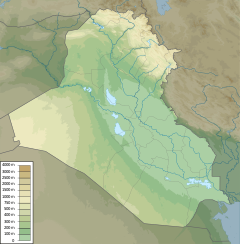| Abdul-Aziz al-Samarrai Mosque | |
|---|---|
| Religion | |
| Affiliation | Islam |
| Ecclesiastical or organisational status | Mosque |
| Status | unknown |
| Location | |
| Location | Fallujah, Iraq |
Location of the former mosque in Iraq | |
| Geographic coordinates | 33°20′42″N 43°47′11″E / 33.3450°N 43.7865°E |
| Architecture | |
| Type | Islamic architecture |
The Abdul-Aziz al-Samarrai Mosque is an Islamic mosque located in Fallujah, Iraq.
The mosque came to worldwide attention when Sunni militants inside the mosque directed small-arms and rocket fire at US Marines. US forces returned fire, when a Cobra helicopter fired a Hellfire missile at the base of the mosque's minaret and an F-16 intentionally dropped a bomb on the mosque.[1][2] A US Marines brigadier general said the mosque would ordinarily have protection under the Geneva Convention, but added that the attacks from inside the building caused it to lose its status. It was initially claimed that forty rebels had been killed in the strike,[3][4][5][6] but it was later stated that no bodies were actually found at the scene. Other sources claim as many as 50 were killed in the attack.[7]
See also[edit]
References[edit]
- ^ Mroue, Bassem; Saad, Abdul-Qader (7 April 2004). "Fighting spreads in Iraq; mosque hit in Fallujah". Deseret News. Associated Press. Retrieved 10 February 2019.
- ^ "Mosque in Fallujah Hit As Fighting Spreads in Iraq". PBS NewsHour. 7 April 2004. Retrieved 10 February 2019.
- ^ "U.S. Hits Mosque Compound in Fallujah". Fox News. 7 April 2004. Retrieved 10 February 2019.
- ^ "Marines: U.S. bombed Iraqi mosque wall". CNN. 7 April 2004. Retrieved 10 February 2019.
- ^ "US bombards Iraq mosque complex". BBC News. 8 April 2004. Retrieved 10 February 2019.
- ^ "40 dead as US bombs Fallujah mosque". The Sydney Morning Herald. Agence France-Presse. 8 April 2004. Retrieved 10 February 2019.
- ^ "U.S. hits Fallujah mosque complex; Rumsfeld signals tour extensions". Seattle Times. 2004-04-08. Archived from the original on 2012-01-11. Retrieved 2012-02-05.

Well, that’s interesting to know that Psilotum nudum are known as whisk ferns. Psilotum nudum is the commoner species of the two. While the P. flaccidum is a rare species and is found in the tropical islands. Both the species are usually epiphytic in habit and grow upon tree ferns. These species may also be terrestrial and grow in humus or in the crevices of the rocks.
View the detailed Guide of Psilotum nudum: Detailed Study Of Psilotum Nudum (Whisk Fern), Classification, Anatomy, Reproduction